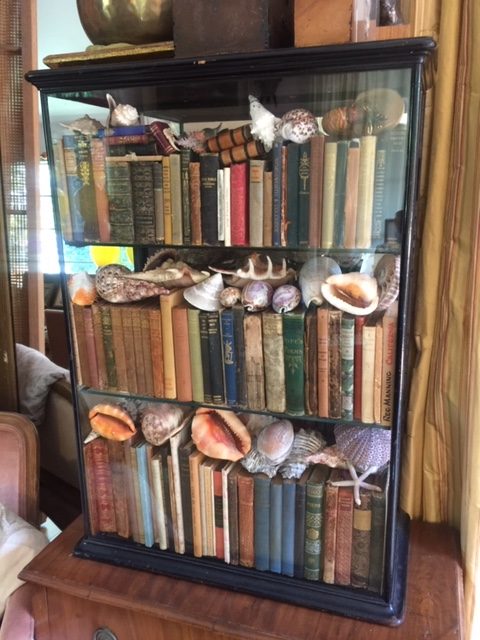 My favorite objects? What in my tiny condo keeps me amused during the Pandemic? And why? Is it beauty, functionality, or symbolism?
My favorite objects? What in my tiny condo keeps me amused during the Pandemic? And why? Is it beauty, functionality, or symbolism?
The first object is a 18th century tea box. You see the iconography of three lovers on the lid. The only man holds a birdcage and his partner leans over perhaps to free the bird, watched by an exquisitely dressed shepherdess, who holds a crook. By her side stands a lamb; in the foreground we see a hound asleep. Nobles of the 18th century immediately understood this allegory, and in fact, only the nobles afforded the new beverage (to Europe) called tea. The lovers toying with the caged bird speak of both the shackles and the freedom love brings. The shepherdess commanding the scene speaks of the “keeper” and the “follower,” the tended and the tender. Of course, the sleeping dog speaks of fidelity, often “asleep” in the course of love. The other scenes on the box show famous watering holes throughout England, Germany, and France of natural wells where the rich could source the best water for tea.
I remember the interior: yes, I lost the key 30 years ago; there are three tole (tin painted) tea casters, also with paintings en grisaille of famous spas. I purchased this at an estate sale in the 1980’s in Dallas, when moneyed folks lost their oil wells. I’ve placed it in each bedroom I’ve occupied since.
Handel Table Lamp
 The second object is a Handel (Meriden, CT) 1910-1920 table lamp, with Renaissance style metal overlay on amber slag glass undulating in a tapering octagonal round shade, with two colors of patinated metal to the classically paneled octagonal base. This is probably worth a bit. I believe I acquired it in my days as a dealer, and it has sat on many of my office desks. One distant lunch break, my secretary, who thought it imitation junk, sold it to a customer. I loved that lamp, and called to explain I wanted to buy it back for double, and the kind gent understood. My secretary also sold a palace sized Persian rug on my office floor because she thought it a polyester imitation, as well, and that I never got back!
The second object is a Handel (Meriden, CT) 1910-1920 table lamp, with Renaissance style metal overlay on amber slag glass undulating in a tapering octagonal round shade, with two colors of patinated metal to the classically paneled octagonal base. This is probably worth a bit. I believe I acquired it in my days as a dealer, and it has sat on many of my office desks. One distant lunch break, my secretary, who thought it imitation junk, sold it to a customer. I loved that lamp, and called to explain I wanted to buy it back for double, and the kind gent understood. My secretary also sold a palace sized Persian rug on my office floor because she thought it a polyester imitation, as well, and that I never got back!
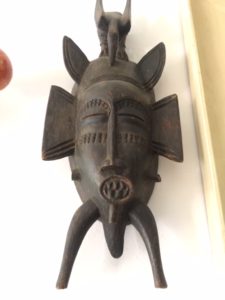 The third object I love is an early 20th century Senufo carved wood mask from the Ivory Coast. I didn’t acquire it in Africa while teaching an abroad program (I taught music of all things!). Later, when I missed my three years in West Africa, I found this mask. You see a bird perched over the forehead. This is a symbol of Poro, the initiation rite of young men into adulthood; the hornbill channels the Ancient Mother, and the ancestors. Over periods of seven years each, the young men raise through various degrees of training. The bird figure worn on the head in ceremony displays strength, both intellectually and physically, with the aim of giving these TOWARDS community. Those long protruding ears speak of knowledge acquired from the deities. I can’t help but marvel at the meaning in this mask, and wonder who made it and wore it.
The third object I love is an early 20th century Senufo carved wood mask from the Ivory Coast. I didn’t acquire it in Africa while teaching an abroad program (I taught music of all things!). Later, when I missed my three years in West Africa, I found this mask. You see a bird perched over the forehead. This is a symbol of Poro, the initiation rite of young men into adulthood; the hornbill channels the Ancient Mother, and the ancestors. Over periods of seven years each, the young men raise through various degrees of training. The bird figure worn on the head in ceremony displays strength, both intellectually and physically, with the aim of giving these TOWARDS community. Those long protruding ears speak of knowledge acquired from the deities. I can’t help but marvel at the meaning in this mask, and wonder who made it and wore it.
BIG mural art of the 1940-early 50’s
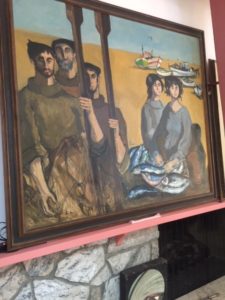 The next three objects reflect my passion for BIG mural art of the 1940-early 50’s. Like many small people, I love BIG art (have you noticed that?). The first painting is a midcentury Portuguese oil over my fireplace. The signature reads Figueroa, a semi-obscure painter of village fishing scenes. I love the way he painted the fish on the lap of the pregnant woman, and I love how the oars break up the picture plane as well as tell the story of work. I also love the raised horizon line. I’ve owned this painting for 30 years, purchased from an older lady who kept it rolled up under her bed. I remember gathering up pennies over a year to have it stretched and framed.
The next three objects reflect my passion for BIG mural art of the 1940-early 50’s. Like many small people, I love BIG art (have you noticed that?). The first painting is a midcentury Portuguese oil over my fireplace. The signature reads Figueroa, a semi-obscure painter of village fishing scenes. I love the way he painted the fish on the lap of the pregnant woman, and I love how the oars break up the picture plane as well as tell the story of work. I also love the raised horizon line. I’ve owned this painting for 30 years, purchased from an older lady who kept it rolled up under her bed. I remember gathering up pennies over a year to have it stretched and framed.
 The other huge piece, INDEED a mural, I found in a Thrift store in Ventura recently. The donor told the store owner he bought “Florida scene” in Florida. I recognized it right away as a scene from the 1940’s straight out of the vineyards in Paso Robles, and it more than likely hung on a wall of a public administration building or post office during the WPA; the style that realistic, work-celebrating WPA style. I love a point of unique focus in a painting. You see how the tall hedges intersect the fields below, leading your eye right to the double focal points of the red roofed farm and typical red roof California barn, with the mountaintop as background anchor to the work. The whole work is in three paper panels laid on drywall. It took six men and a liftback truck to get it from Ventura to my living room. At six by nine feet it sits on the floor. I have yet to discover the artist.
The other huge piece, INDEED a mural, I found in a Thrift store in Ventura recently. The donor told the store owner he bought “Florida scene” in Florida. I recognized it right away as a scene from the 1940’s straight out of the vineyards in Paso Robles, and it more than likely hung on a wall of a public administration building or post office during the WPA; the style that realistic, work-celebrating WPA style. I love a point of unique focus in a painting. You see how the tall hedges intersect the fields below, leading your eye right to the double focal points of the red roofed farm and typical red roof California barn, with the mountaintop as background anchor to the work. The whole work is in three paper panels laid on drywall. It took six men and a liftback truck to get it from Ventura to my living room. At six by nine feet it sits on the floor. I have yet to discover the artist.
Elephant Fest Mural
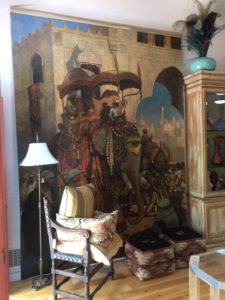 The last huge mural in my little condo offers a dramatic portrayal of the Elephant Fest (“Holi”) in March in Jaipur, Rajasthan State, India. We see an ancient procession of the elephant, bedecked with ear dangles, anklets, huge jewels, velvet embroidered headplates, and gold and silver tusk ornaments. In this mural a Prince and his veiled consort rides their elephant to the Amber Palace of Rajasthan. In Indian myth, demons stirred the ocean from which arose nine jewels, one of these the elephant, a symbol of royalty. I found this in Santa Barbara rolled up and quite discolored, but I saw enough greatness in its twelve by nine foot size that I knew I needed to have it restored. I had no idea WHERE or HOW to hang it once I did.
The last huge mural in my little condo offers a dramatic portrayal of the Elephant Fest (“Holi”) in March in Jaipur, Rajasthan State, India. We see an ancient procession of the elephant, bedecked with ear dangles, anklets, huge jewels, velvet embroidered headplates, and gold and silver tusk ornaments. In this mural a Prince and his veiled consort rides their elephant to the Amber Palace of Rajasthan. In Indian myth, demons stirred the ocean from which arose nine jewels, one of these the elephant, a symbol of royalty. I found this in Santa Barbara rolled up and quite discolored, but I saw enough greatness in its twelve by nine foot size that I knew I needed to have it restored. I had no idea WHERE or HOW to hang it once I did.
The artist is Zoltan L. Sepeshy (Hungarian/American 1898-1974), head of the painting department at Cranbrook School 1930-31, Bloomfield Hills MI. Later he became resident artist, followed by his tenure as Director of the school and later President, and retired in 1966. He was highly regarded in his time, having a pivot place in the development of the Cranbrook ethos. He painted mainly in the social realist style of the 1940’s. Major magazines, such as Fortune, sought him out for illustration commissions. I bet this big canvas was a commission for an illustration of the Elephant Festival.
Story Behind All Objects
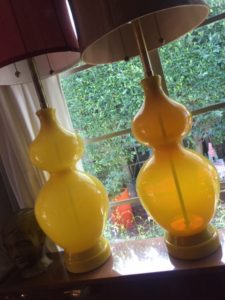 There’s a story behind all objects, and the pair of Italian blown glass lamps, perhaps Murano, from the 1950’s, on my piano are no exception. I love the color they add to any room, and of course my partner broke one almost completely, but I salvaged the base. Then the movers broke the BASE of the existing lamp. So, I put that base on the damaged lamp, but missed having a PAIR. One day at an antique mall I saw ONE just like mine. I hate paying retail but couldn’t resist. So now I have a pair again.
There’s a story behind all objects, and the pair of Italian blown glass lamps, perhaps Murano, from the 1950’s, on my piano are no exception. I love the color they add to any room, and of course my partner broke one almost completely, but I salvaged the base. Then the movers broke the BASE of the existing lamp. So, I put that base on the damaged lamp, but missed having a PAIR. One day at an antique mall I saw ONE just like mine. I hate paying retail but couldn’t resist. So now I have a pair again.
The final set of objects I treasure is a collection of early 20th century miniature books, poetry, inspiration, jokes, travel views, from the days when we considered a book the perfect gift. I have half a storage locker with such vintage books and nowhere to display them except for this little glazed barber shop case. When I kick the bucket, my son will hate me.
